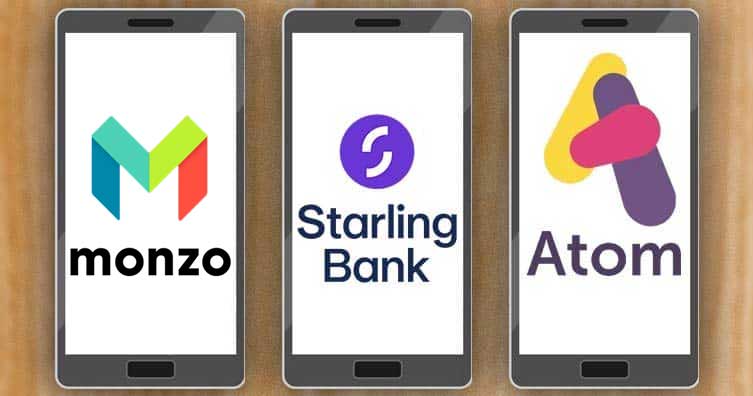Best app-based and online bank accounts
The future of banking is here and it's on your mobile. We've got the lowdown on the best app-based banks and how they work...

App-based banks are also often called online-only banks, digital banks, mobile banks or challenger banks. These new banking products, which range from current accounts to cryptocurrencies, exist purely on your smartphone.
Many of the services they offer are far cheaper than mainstream banks accounts, especially currency exchange.
We've reviewed the best banking apps available in the UK. Find out which banks best help you save money, budget and even start stock market trading.
Compare app-only banks:
What are app-based banks?
Online banks exist purely in digital form, usually on apps. Examples are banks like Monzo and Starling Bank (more on these later).
These banks don't have any physical branches that you can pop into like traditional banks. You'll still have access to customer support and advice through the app. And you'll still receive a physical debit card in the post along with a sort code and account number.
Through digital banking, you can set up Direct Debits, transfer money and pay bills in the same way that you would with a traditional bank account.
The best online banks are free to join, although there are costs for premium products.
The explosion of app-only banking is a result of the UK government introducing 'open banking'. Banks must now allow customers to share financial data (such as spending habits, regular payments, bank statements etc.) with budgeting apps or other banks.
Why choose an online bank over a traditional bank?
More and more people are choosing to open an app-based bank account to gain greater control over their finances.
So far, it seems most adopters of banking apps are using them in conjunction with a ‘traditional’ account.
There are no rules on how many current accounts you can have. So you don’t have to make a full switch.
App-based banks boast brand-new digital banking technology and offer things you probably won’t get at your typical bank.
Benefits of online banking
These are the best features you can get with free online bank accounts:
- Real-time notifications direct to your phone each time you spend money
- Budgeting tools that help you to set spending goals and over-spending alerts
- Fee-free overseas spending
- Auto-saving features which regularly set aside money in separate pots
- Fast in-app card cancellation
- In-credit interest (in some cases).
All banking apps are positioned slightly differently and each excels in specific areas, which we explore in our reviews below.
Is online banking safe?
Plenty of people are still wary about storing their money in an app-only bank that relies on online banking. What happens if the company goes bust? Will you lose all your money?
App-based banks that are fully licensed banks, including Starling Bank, Monzo and Atom Bank, are all protected by the Financial Services Compensation Scheme (FSCS). This means that your money (up to £85,000) is protected should the bank go bust.
Meanwhile, Revolut and Monese don’t currently hold UK banking licences (so aren’t covered by FSCS) but are covered by the Financial Conduct Authority (FCA).
Effectively your funds are stored completely separately in a licensed bank that the app company partners with.
This means if one of these apps goes bust, you’ll get 100% of your money back. However, if the bigger bank that was used to store your money happens to go bust, your money might not be protected.
Online bank reviews
Revolut
Current account features
Revolut is currently not an officially licensed bank in the UK – which means it can’t offer overdrafts or FSCS protection. However, Revolut is regulated by the Financial Conduct Authority (FCA) and your money is protected within segregated accounts with licensed banks.
Some of Revolut’s best features are:
- 3 months free premium when you sign up through our unique link
- Note: a card delivery charge will apply if you don’t continue with premium after the trial
- Real-time notifications
- Simple analytics to track spending habits
- Instantly freeze/unfreeze cards
- Turn off online, ATM and contactless payments
- Savings vaults with up to 4.75% AER on GBP
- Spend and send money abroad with no fees
- Use the app to buy and exchange cryptocurrency
- Split the bill function (even if they don’t have the app)
- Set up recurring payments
- Revolut Perks including cashback or discount offers
- Free debit card (delivery fee applies)
- Open Banking allows you to view and manage all your bank accounts via the Revolut app
- Discounted or unlimited airport lounge access on the Premium, Metal and Ultra plans.
These are the things to watch out for with Revolut:
- Revolut is covered by the FCA but not the FSCS.
- You can only withdraw £200 cash for free each month or make five withdrawals (whichever one comes first) on the Standard plan – after that, you’ll be charged 2% on all ATM withdrawals, with a £1 minimum fee.
- If you want more features, higher withdrawal limits, and better rates on cryptocurrencies and precious metals, you can upgrade to the Revolut Plus, Premium, Metal or Ultra plans. But keep in mind that these come with a monthly fee.
Buy and exchange cryptocurrency
One of Revolut’s big selling points is that it makes it super easy to trade cryptocurrencies.
If you’re new to crypto, check out our Bitcoin guide for all the basics, including how to get started and calculate risk.
Revolut allows you to exchange any of its 30+ featured fiat currencies (e.g. pound sterling, euros, US dollars) into Bitcoin, Ethereum, Litecoin, Bitcoin Cash, Ripple and more. It charges a fee of 1.49% for Standard and Plus users, 0.99% for Premium and Metal users, and 0.49% for Ultra users. For Standard and Plus users, there is a £1.49 minimum fee, while there is no minimum fee for the other plans.
You can also use the app to follow real-time cryptocurrency rates and receive price alerts straight to your phone. It’s also possible to set target prices, where your cryptocurrencies are automatically exchanged when it reaches a specific price.
But be aware that the cryptocurrency feature is not protected by the FSCS or the FCA.
Create Vaults
Revolut’s Vaults work in a very similar way to equivalents from other banks, like Starling’s Spaces or Monzo’s Pots. You can set them up in seconds, and use them as a way to quickly and easily save up cash.
You can round up purchases to the nearest pound and save the difference, or set up weekly or monthly recurring payments. It’s even possible to give them a name so you’ll be extra motivated to start saving.
Send and spend money abroad for free
Unlike many banks which will add on hefty charges, Revolut uses the wholesale Interbank Exchange Rate (which banks use to trade between themselves). If you’re a Standard or Plus user, you can use the app to send up to £1,000 or £3,000 respectively at this rate each month. You’ll pay a small fee of 1% (for Standard users) or 0.5% (for Plus users) on transfers over this monthly limit.
Spending money abroad with Revolut is slightly different. There is no transfer fee when transferring money in the SEPA region in Euros.
For payments to non-Revolut users outside the SEPA region, there will be a fee, but it depends on where you’re sending it. You can calculate the fees here before making your decision. Premium and Metal users receive a discount on these. For Ultra users, it’s free.
Starling Bank
Current account features
For a well-rounded current account that uses digital banking, Starling Bank is your best option. Its accounts offer a wide range of features, including in-credit interest, overdrafts, savings goals and fee-free spending abroad.
Here’s a quick rundown of the main features of Starling Bank accounts:
- Real-time notifications on your phone as you spend.
- Insights into your spending habits.
- Savings Spaces which you can set and monitor.
- Round up transactions to the nearest pound, with the spare change automatically put into your savings.
- Lock and unlock your card in-app.
- Turn off certain spending functions, e.g. online spending or contactless payments.
- Free cash deposits up to £1,000 per calendar year into your personal or joint account via any Post Office. Anything over the limit will be charged at 0.7%.
- 24/7 in-app customer support.
- ‘Settle Up’, which allows you to get paid back or split the bill in seconds.
- No extra charges for spending abroad.
- 3.25% in-credit interest.
- Allow joint accounts.
Things to watch out for:
- You’ll be charged for using an overdraft (fees are made clear)
- Maximum six cash withdrawals a day, up to £300.
Earning interest
A major thing that puts Starling Bank ahead of the pack is the interest paid on balances held with them.
Most current accounts don’t offer interest at all, so this isn’t a bad deal. You’ll get 3.25% AER on balances up to £5,000.
Behind all the banking jargon this basically means that, unlike most other banking apps, you’ll actually be making money when you use Starling – bonus!
Overdraft
Starling Bank does have an overdraft facility (subject to approval) but you’ll be charged 15%, 25% or 35% EAR (variable) based on your credit score. While students can apply, there is no student-specific overdraft at this time, so it’s better to get a 0% interest overdraft from one of the best student bank accounts (which you can transfer across).
You can apply for an overdraft as soon as you open the app. If you’re approved, you can choose the overdraft amount (up to £5,000). It’s best to only select the overdraft amount you actually need to stop yourself from spending the full overdraft just because it’s there.
Interest is accrued daily and then charged to your account every month, but this will all be clearly laid out in the app. As an example, if you borrowed £100 for 30 days at 15%, it would cost you £1.16.
Starling Bank will conduct a credit check before giving you an overdraft (but they won’t if you’re just opening an account).
Spending abroad
Starling Bank is one of the best online banks for spending abroad, as it won’t charge you for using your debit card abroad or for taking out cash at ATMs (although remember that individual ATMs might have their own charges).
It uses Mastercard’s exchange rates (with no extra fees), and you won’t be charged for the card or for topping it up. Make sure to check out our other top tips for saving on travel money.
Joint account
Starling is one of the few digital banking apps which allows anyone to set up a joint account.
These are great if you’ve got a partner or friend with whom you share financial commitments – perhaps you live together and want a joint account for paying the bills.
Once you’re both on Starling, it takes just minutes to set up. Then you’ll both be able to add and spend money. Starling joint accounts are for a maximum of two people, so won’t work if you’re wanting to split the bills between more people in a house share.
Kroo
Current account features
Kroo is another fully licensed digital bank with FSCS protection. One thing that sets this bank apart is its sustainable approach to banking along with the high in-credit interest rates. It’s definitely a great app-based bank to consider!
Some of Kroo’s best features include:
- Gain 4.35% AER interest on your current account
- Zero fees when spending abroad
- Kroo plants two trees for every new customer joining
- Easily split expenses with friends or housemates
- Real-time information about your spending
- Free and unfreeze your card on the app
- Biometric authentication for extra security
- Support available in-app
- Free debit card.
These are the things to watch out for with Kroo:
- The overdrafts available come with high fees
- Kroo doesn’t support cash or cheque deposits
- You can only withdraw up to £200 abroad each month without having to pay extra fees.
In-credit interest
Similarly to Starling, Kroo offers in-credit interest. This means that you earn interest on your current account – not many other banks offer this. Where Starling offers 3.25%, Kroo offers a staggering 4.35%.
The interest is calculated daily and added to your account every month. No need to move money across accounts anymore – a very easy way to earn some extra cash.
Sustainability
One thing we love about Kroo is its approach to sustainability. At Save the Student, we’re always looking at ways to cut our carbon footprint, and Kroo seems to be on the same page.
Kroo is planning to plant one million trees – for every new customer, two trees are planted in communities where it makes a real impact. Not only to cut carbon emissions, but also to reduce shoreline erosion and protect against extreme weather events (such as floods, storms and hurricanes).
Chase
Current account features
Chase is one of the biggest banks in the USA, and it’s recently made its way across the pond to the UK.
However, the big difference with Chase in the UK, is that here it’s an app-only bank – no physical branches will be popping up in your town. It is still a bank though, meaning you get FSCS protection on up to £85,000 in your account.
Here are the headline features of Chase’s bank account:
- 1% cashback on everyday debit card spending for your first year (max £15 per month, cashback exceptions apply)
- 1% AER variable interest rate on current account balance
- A linked savings account with a 4.1% AER variable interest rate
- Access to 5% AER variable interest with a round-up account
- No charges from Chase for spending abroad
- A numberless debit card which helps keep your details safe if you lose it (although they are all accessible in the app)
- Spending insights and budgeting tips in the app
- Card controls so you can decide how and where it’s used (e.g. freeze contactless or gambling payments)
- 24/7 customer support is available through the app.
Things to watch out for:
- You’re currently unable to deposit cash or cheques into your Chase account
- Despite being a registered bank, Chase doesn’t offer overdrafts
- App isn’t yet available on all phones.
4.1% AER on savings and 5% AER with a round-up account
As a Chase current account holder, you’ll have exclusive access to its linked savings account. This offers a variable interest rate of 4.1% AER (4.02% gross) paid monthly, which makes it a great easy-access savings account.
You can also earn interest on your spare change with a linked round-up account.
By activating this feature in the app, all of your spending is automatically rounded up to the nearest whole pound. The difference will be saved in a round-up account that gives you 5% AER (4.89% gross) variable, calculated daily and paid monthly.
You can choose to access and spend this cash whenever you like. But if you’d rather leave it be for the time being, that’s fine too. Just note that Chase will automatically transfer the balance to your Chase current or saver account on the anniversary of account opening.
1% cashback on everyday debit card spending
While there’s no need to fully switch your bank account to Chase, the 1% cashback offer could make it a sensible choice. For your first year as a Chase customer, you can get 1% cashback – up to £15 per month – on your everyday debit card spending.
With Chase, you’ll get 1% refunded on the first £1,500 of eligible spending each month. There are a few types of payments that are excluded (listed on Chase’s website), but all of your usual day-to-day purchases like groceries and even travel are eligible.
This is the very definition of free money, so why not make Chase your main account for spending.
Spending abroad
Chase is a great bank for spending abroad. There are absolutely no fees from Chase for using your card overseas and any purchases you make in the local currency will be converted using Mastercard’s exchange rate.
There are also no charges from Chase for withdrawing cash abroad, excluding any charges a local bank may impose. However, you should note that Chase only lets you withdraw up to £500 a day from cash machines (in the UK or abroad), and that’s capped at £1,500 per calendar month if you’re outside the UK.
Monzo
Current account features
Monzo is incredibly similar to Starling Bank in terms of its structure and the features it offers to keep track of your money.
It used to be a prepaid card. But, following its transformation into a fully licensed bank in 2017, users now have their own current accounts with sort codes and account numbers.
The app and card work in essentially the same way as before, except now you can set up Direct Debits and apply for an overdraft.
Here are some of Monzo’s main features:
- Real-time notifications whenever you spend
- Savings Pots that set money aside by rounding up every purchase you make
- Various savings accounts and ISAs for long-term savings, with interest rates of up to 4.75% AER (not all accounts are available at all times)
- Easy Access accounts for short-term savings with an interest rate up to 4.60% AER (but some Savings Pots aren’t available at all times)
- Set budget spending targets for everything from groceries to eating out (and notifications if you’re going over budget)
- Easily split the bill with friends
- Create a shared tab with friends when on a night out or with your housemates to keep track of how much everybody owes you
- ‘Get Paid Early’ salary advance feature
- Free spending abroad
- ATM withdrawals within the EEA are fee-free, and you can withdraw £200 per month in other countries without paying any extra fees
- Monzo does Joint Accounts too (but you both have to have your own separate account to apply).
Things to watch out for:
- You can only withdraw £400 a day
- There are charges for withdrawing more than £200 per month in certain countries (see below)
- You’ll be charged interest for using an overdraft
- Monzo has Plus and Premium accounts, but we recommend sticking with the free version due to the monthly fees and limited extra features.
Our former Content Editor, Nele van Hout, only has good things to say about her Monzo account:
Monzo is my favourite budgeting tool. At the start of the month, I transfer my spending money to it and only use my Monzo card when I’m out. That way, I’m never tempted to overspend from my main account.
I also use the round-up pots as an extra way to sneakily save money without even noticing. You don’t really notice that you’re putting money away, but it adds up quickly.
Over a year I’ll save a couple of hundred pounds then empty it once a year (often when it’s time for Christmas shopping).
Savings pots
Monzo Pots are designed to help customers set aside and save money. Creating a new pot takes seconds and you can add a custom image. For example, if you’re saving up for a holiday, you could create a pot called ‘Trip to Spain’ and upload a picture of a nice sunny beach.
Money that’s in a pot can’t be spent and won’t appear in your available balance. However, if you run out of money, you can easily transfer funds out of your savings pots and back into your current account to use it again.
If you turn on roundups on a pot, Monzo will automatically round up any purchases over £1 and add the difference to the pot. So, if you buy lunch for £4.25, Monzo will round it up to a fiver and add the 75p to your pot.
Monzo has also entered the savings accounts and cash ISAs games. The ‘Fixed’ savings pots can be used for long-term savings of £500 or more with fixed interest rates of up to 4.75% AER. For short-term savings goals, you can opt for the ‘Easy Access’ savings pots (including the Cash ISA options), giving you up to 4.60% AER for premium customers and 4.10% for non premium. Not all accounts are available at all times, however.
Both of these options are provided in partnership with other UK banks and are actual savings accounts, unlike regular ‘pots’ which allow you to put money aside without earning interest.
Spending abroad
Monzo has completely free spending abroad. It uses Mastercard’s exchange rate and don’t add any extra charges.
Within the UK/European Economic Area (EEA), cash withdrawals from ATMs are free with Monzo Plus or Monzo Premium (but remember some ATMs can charge). If you’re on Monzo’s free plan and you use it as your main bank, you will also have free cash withdrawals abroad, but if it’s not your main bank account you’ll be charged 3% on withdrawals over £400 every 30 days.
In other countries, you can only withdraw up to £200 over a 30 day period before needing to pay 3% on withdrawals. This limit is higher on Monzo Plus (up to £400) and Monzo Premium (up to £600).
Overdraft fees
Monzo offers overdrafts of up to £2,000. If you use an overdraft you’ll be charged 19%, 29% or 39% EAR (variable) depending on your credit score.
To put this into perspective, if you use an arranged overdraft of £1,000 for 30 days, with 39% EAR (variable), it would cost you £27.45.
If you don’t have an overdraft, Monzo will simply decline any payments which take you over your limit, but this won’t work for ‘offline’ payments like those through TfL or on aeroplanes. In this case, you’ll go into the red and start incurring the percentage charge.
Get Paid Early
Fancy an early payday? With Monzo, you can.
If you have a job and arrange for your salary to be paid into your Monzo account, Monzo can advance you your wages at 4pm the day before the money is due to leave your employer’s account.
Monese
Current account features
Like Revolut, Monese isn’t a fully licensed bank but a registered Electronic Money Institution monitored by the FCA. Your money is kept separate from the company’s finances and will be protected if the app goes bust.
They offer all the usual perks and are especially useful for international students. But, unlike some of the other apps, there are quite a few fees to be aware of with Monese.
Here’s a rundown of the main features of Monese accounts:
- No proof of address, credit history or regular income needed to open an account
- Real-time notifications to keep track of spending
- Lock and unlock your card instantly in the app
- Deposit cash into your account at the Post Office, PayPoint shop or Paysafecash location
- Transfer money abroad in different currencies using real wholesale exchange rates
- Transfer money to your account from outside the UK using their European IBAN
- Open both a UK and Eurozone current account at no extra cost, allowing you to spend in GBP and Euros
- You can earn money by referring friends.
Things to watch out for with Monese:
- There is a £4.95 card delivery fee
- Simple account exchange fees start from 2% of the transaction value (plus an additional 1% on weekends) for international bank transfers to non-Monese accounts, plus there’s a 2% fee for foreign currency card spending.
- The ATM withdrawal limit is £300.
- There’s no overdraft facility. If you do end up with a negative balance, you won’t be charged but your account will be locked until you top up.
Anyone can open a Monese account
One of Monese’s biggest selling points is that virtually anyone can open an account with them, regardless of how long they’ve been living in the UK.
Unlike pretty much all other banks, you don’t need to provide proof of address to set up an account. If you’ve just arrived in the UK from abroad, you can still get a current account set up straight away.
You’ll just need to take a selfie and a photo of your ID (preferably a passport or ID card), and you’re set. You’ll have an account number and sort code in minutes. Plus, there’s no minimum balance requirement, so you don’t need to deposit cash straight away.
Once your account is open, you can receive and make payments, and set up Direct Debits, just like you would with any other current account.
Deposit cash
Since app-based banks don’t have any physical branches, it’s normally not possible to deposit cash into your account.
However, Monese has paired up with the Post Office and PayPoint so you can deposit cash that way. Simply head along to any Post Office branch, or a shop with a PayPoint sign, hand over your Monese card and the cash you want to deposit, and the money will appear in your account the next business day.
However, you will be charged for this service. With a Simple account, you’ll be charged 3.5% (min. £3). With the Classic account, you’ll have a £400 monthly allowance and will be charged 3.5% for cash top-ups over this amount. If you have a Premium account, your monthly allowance is £1,000, and any cash top-ups over this amount will be charged at 3.5%.
There are also caps on how much you can deposit – between £5 and £250 per transaction/£500 per day/£1,000 per week/£1,300 per month at the Post Office. For PayPoint, the limit is £249 per transaction/£500 per day/£1,300 per week.
It’s a useful service to have access to, but the hefty charges arguably make it pretty worthless. You’d be better off depositing cash at a traditional bank and transferring it across to your Monese account.
Other ways to deposit money
As well as depositing money in cash form, you can also top up your account by standard bank transfers, IBAN transfers or instant debit card top-ups.
If you’re abroad, you can transfer money into your account via the Monese European IBAN (International Bank Account Number). Simply use the IBAN details provided and include your Monese ID in the reference. Euros will then be converted into GBP and added to your account, or if you have a Eurozone account, they’ll be directed straight there.
You can also instantly top up your account using a debit card that is also in your name for free.
Atom Bank
Atom Bank is a fully licensed bank, but it doesn’t offer current accounts like Starling and Monzo. Instead, it specialises in savings accounts and mortgages, offered through digital banking.
Although it might introduce current accounts and debit cards in the future, at the moment, you can’t generally use Atom for day-to-day spending.
Biometric security
One unique feature of Atom Bank is its use of biometric security. This means that, unlike most other apps which use touch ID, the Atom app uses face and voice recognition instead (along with a passcode).
To access the app you might need to take a selfie or read a phrase out loud – which is arguably much easier than trying to remember complicated passcodes or security questions.
Fixed Savers
Atom’s main product is its fixed savings accounts. You can open an account in minutes, and start saving with anything from £50 – £100,000.
For each savings account, you can choose between monthly or annual interest (you’ll likely get a slightly better deal if you go for monthly interest).
The interest rates on the Fixed Saver accounts are 4.5% – 5.1% AER at the time of writing.
However, remember that as with most fixed-rate savings accounts, you can’t withdraw your money until it reaches maturity. Make sure you’re definitely not going to need the money before you squirrel it away in a fixed-rate account.
Instant Savers
As well as fixed savings accounts, Atom also offers instant ones which allow you to save any amount up to £100,000, and access your savings whenever you wish.
To transfer money in and out, you’ll need to connect your Atom Instant Saver account with your current account.
At the time of writing, Atom is offering interest of 4.11% AER on its instant-access savings account.
Mortgages
It might be a bit too soon to start thinking about buying a house as a student, but another of Atom’s main products is its mortgages. It has a network of brokers who can advise you on your situation and your best option.
Once you’ve applied, you can track your application in-app and continue to manage it from there when it’s accepted – simple!
Fact: saving a penny a day makes it easier than ever to save money.








